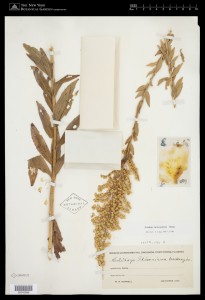In Search of Thomas Edison’s Botanical Treasures
Posted in Applied Science on October 30, 2013 by Lisa Vargues
Lisa Vargues is a Curatorial Assistant at the New York Botanical Garden’s William and Lynda Steere Herbarium. Her work includes digitizing plant specimens for the C. V. Starr Virtual Herbarium, with a focus on the West Indies, the Amazon Basin, and historical specimens from the United States, Canada, and Mexico.

The quiet corridors of the William and Lynda Steere Herbarium here at The New York Botanical Garden are lined with steel cabinets where preserved plant specimens are stored for scientific study, but they are also a treasure trove of history, filled with stories waiting to be told.
One of those stories came to light recently when I set out to determine whether any traces remained in the Steere Herbarium of a significant but little-known research project that involved one of America’s most famous inventors—Thomas Alva Edison.
In the late 1920s, Edison was on a quest for plants that could be grown locally, quickly, and economically to produce latex and provide America with a domestic source of rubber. At the time, the country was dependent on imported rubber for such important products as automobile tires, and Edison and his friends Henry Ford and Harvey Firestone were concerned that an international crisis such as a war could cut off that supply. In 1927, they formed the Edison Botanic Research Corporation in Fort Myers, Florida, and Edison enlisted crews to collect plant specimens throughout the United States, particularly in the South.
Edison’s quest brought him to the Botanical Garden to conduct botanical research in collaboration with the Garden’s Head Curator, John Kunkel Small. At one point the inventor who perfected the light bulb even had a small laboratory in the grand Beaux-Arts building that now houses The LuEsther T. Mertz Library. Tests concluded that the goldenrod (in the plant genus Solidago) contained the most promising amount of latex.
